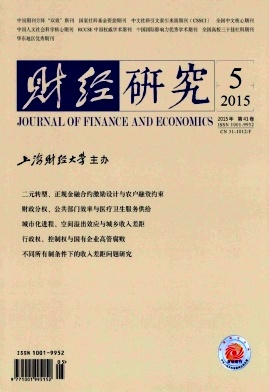制度质量、投资动机与中国对外直接投资的区位选择
财经研究 2015 年 第 41 卷第 05 期, 页码:
摘要
参考文献
摘要
东道国制度质量如何影响中国对外直接投资(OFDI)的区位选择,至今尚未在经验层面达成共识。文章基于2003-2012年中国面向全球142个国家和地区的非金融类OFDI数据,利用Heckman两阶段选择模型和扩展投资引力模型,从母国投资动机和东道国制度质量双重约束视角,考察东道国的政治、经济与法律制度对不同类型OFDI投资选择和投资规模的约束作用。研究表明:(1)中国OFDI的投资选择和投资规模表现出不同的制度偏好,OFDI投资规模更偏好优越的制度环境,而投资选择则偏好较差的制度环境。(2)多元化的母国投资动机使中国OFDI面向不同国家或地区表现出差异化的制度偏好,技术寻求型OFDI投资规模对优越制度的依赖较弱,甚至会偏好制度环境较差的国家或地区,而良好的政权稳定性、政府效率、监管质量和腐败控制是影响市场寻求型和资源寻求型OFDI投资行为最为关键的制度因素,对其投资规模有着强劲的正向作用。在中国调整投资结构的背景下,文章对中国优化OFDI区位分布决策和企业“走出去”具有重要的启示。
关键词
[1][德] 奥古斯特·勒施. 经济空间秩序——经济财货与地理间的关系[M].王守礼,译.北京:商务印书馆,1995.
[2]程慧芳,阮翔. 用引力模型分析中国对外直接投资的区位选择[J]. 世界经济,2004,(11):23-30.
[3]池建宇,方英. 中国对外直接投资区位选择的制度约束[J]. 国际经贸探索,2014,(1):81-91.
[4]邓明. 制度距离、“示范效应”与中国OFDI的区位分布[J]. 国际贸易问题,2012,(2):123-135.
[5]蒋冠宏,蒋殿春. 中国对发展中国家的投资——东道国制度重要吗?[J]. 管理世界,2012,(11):45-56.
[6]李磊,郑昭阳. 议中国对外直接投资是否为资源寻求型[J]. 国际贸易问题,2012,(2):146-157.
[7]罗伟,葛顺奇. 中国对外直接投资区位分布及其决定因素——基于水平型投资的研究[J]. 经济学(季刊),2013,(7):1443-1464.
[8]王恕立,向姣姣. 对外直接投资逆向技术溢出与全要素生产率:基于不同投资动机的经验分析[J]. 国际贸易问题,2014a,(9):109-119.
[9]王恕立,向姣姣. 创造效应还是替代效应——〖JP2〗中国OFDI对进出口贸易的影响机制研究[J]. 世界经济研究,〖JP〗2014b,(6):66-72.
[10]王永钦,杜巨澜,王凯. 中国对外直接投资区位选择的决定因素:制度、税负和资源禀赋[J]. 经济研究,2014,(12):126-142.
[11]肖慧敏,刘辉煌. 中国企业对外直接投资的学习效应研究[J]. 财经研究,2014,(4):42-55.
[12]闫大颖. 中国企业对外直接投资的区位选择及其决定因素[J]. 国际贸易问题,2013,(7):128-135.
[13]张春萍. 中国对外直接投资的贸易效应研究[J]. 数量经济技术经济研究,2012,(6):74-85.
[14]张建红,周朝鸿. 中国企业走出去的制度障碍研究——以海外收购为例[J]. 经济研究,2010,(6):80-91.
[15]宗芳宇,路江涌,武常岐. 双边投资协定、制度环境和企业对外直接投资区位选择[J]. 经济研究,2012,(5):71-82.
[16]Anderson J E. A theoretical foundation for the gravity equation[J]. American Economic Review, 1979, 69 (1): 106-116.
[17]Buckley P J, Clegg L J,Cross A R, et al. The determinants of Chinese outward foreign direct investment[J]. Journal of International Business Studies, 2007, 38(4): 499-518.
[18]Dunning J H. Trade, location of economic activity and the MNE: A search for an eclectic approach [M].London: Macmillan, 1977.
[19]Dunning J H. Location and the multinational enterprise: A neglected factor? [J]. Journal of International Business Studies, 1998, 29 (1): 45-66.
[20]Dunning J H,Lundan S M. Institutions and the OLI paradigm of the multinational enterprise[J]. Asia Pacific Journal of Management, 2008, 25 (4): 573-593.
[21]Gani A. Government and foreign direct investment links: Evidence from panel data estimations[J]. Applied Economic Letters, 2007, 14 (10): 753-756.
[22]Heckman J J. Sample selection bias as a specification error[J] . Econometric, 1979, 47 (1): 153-161.
[23]Kolstad I, Wiig A. What determines Chinese outward FDI? [J] . Journal of World Business, 2012, 47,(1): 26-34.
[24]Luo Y, Xue Q, Han B. How emerging market governments promote outward FDI: Experience from China[J]. Journal of World Business, 2010, 45 (1): 68-79.
[25]Salidjanova, N. Going out: An overview of China’s outward foreign direct investment [R]. US-China Economic and Security Review Commission, 2011.
[26]Shafter W E,Fukukawa K, Lee G M. Values and the perceived importance of ethics and social responsibility: The US versus China [J]. Journal of Business Ethics, 2007, 70 (3): 265-284.
[27]Zhang J H, Zhou C H, Ebbers H. Completion of Chinese overseas acquisitions: Institutional perspectives and evidence[J]. International Business Review, 2011, 20 (2): 226-238.
[2]程慧芳,阮翔. 用引力模型分析中国对外直接投资的区位选择[J]. 世界经济,2004,(11):23-30.
[3]池建宇,方英. 中国对外直接投资区位选择的制度约束[J]. 国际经贸探索,2014,(1):81-91.
[4]邓明. 制度距离、“示范效应”与中国OFDI的区位分布[J]. 国际贸易问题,2012,(2):123-135.
[5]蒋冠宏,蒋殿春. 中国对发展中国家的投资——东道国制度重要吗?[J]. 管理世界,2012,(11):45-56.
[6]李磊,郑昭阳. 议中国对外直接投资是否为资源寻求型[J]. 国际贸易问题,2012,(2):146-157.
[7]罗伟,葛顺奇. 中国对外直接投资区位分布及其决定因素——基于水平型投资的研究[J]. 经济学(季刊),2013,(7):1443-1464.
[8]王恕立,向姣姣. 对外直接投资逆向技术溢出与全要素生产率:基于不同投资动机的经验分析[J]. 国际贸易问题,2014a,(9):109-119.
[9]王恕立,向姣姣. 创造效应还是替代效应——〖JP2〗中国OFDI对进出口贸易的影响机制研究[J]. 世界经济研究,〖JP〗2014b,(6):66-72.
[10]王永钦,杜巨澜,王凯. 中国对外直接投资区位选择的决定因素:制度、税负和资源禀赋[J]. 经济研究,2014,(12):126-142.
[11]肖慧敏,刘辉煌. 中国企业对外直接投资的学习效应研究[J]. 财经研究,2014,(4):42-55.
[12]闫大颖. 中国企业对外直接投资的区位选择及其决定因素[J]. 国际贸易问题,2013,(7):128-135.
[13]张春萍. 中国对外直接投资的贸易效应研究[J]. 数量经济技术经济研究,2012,(6):74-85.
[14]张建红,周朝鸿. 中国企业走出去的制度障碍研究——以海外收购为例[J]. 经济研究,2010,(6):80-91.
[15]宗芳宇,路江涌,武常岐. 双边投资协定、制度环境和企业对外直接投资区位选择[J]. 经济研究,2012,(5):71-82.
[16]Anderson J E. A theoretical foundation for the gravity equation[J]. American Economic Review, 1979, 69 (1): 106-116.
[17]Buckley P J, Clegg L J,Cross A R, et al. The determinants of Chinese outward foreign direct investment[J]. Journal of International Business Studies, 2007, 38(4): 499-518.
[18]Dunning J H. Trade, location of economic activity and the MNE: A search for an eclectic approach [M].London: Macmillan, 1977.
[19]Dunning J H. Location and the multinational enterprise: A neglected factor? [J]. Journal of International Business Studies, 1998, 29 (1): 45-66.
[20]Dunning J H,Lundan S M. Institutions and the OLI paradigm of the multinational enterprise[J]. Asia Pacific Journal of Management, 2008, 25 (4): 573-593.
[21]Gani A. Government and foreign direct investment links: Evidence from panel data estimations[J]. Applied Economic Letters, 2007, 14 (10): 753-756.
[22]Heckman J J. Sample selection bias as a specification error[J] . Econometric, 1979, 47 (1): 153-161.
[23]Kolstad I, Wiig A. What determines Chinese outward FDI? [J] . Journal of World Business, 2012, 47,(1): 26-34.
[24]Luo Y, Xue Q, Han B. How emerging market governments promote outward FDI: Experience from China[J]. Journal of World Business, 2010, 45 (1): 68-79.
[25]Salidjanova, N. Going out: An overview of China’s outward foreign direct investment [R]. US-China Economic and Security Review Commission, 2011.
[26]Shafter W E,Fukukawa K, Lee G M. Values and the perceived importance of ethics and social responsibility: The US versus China [J]. Journal of Business Ethics, 2007, 70 (3): 265-284.
[27]Zhang J H, Zhou C H, Ebbers H. Completion of Chinese overseas acquisitions: Institutional perspectives and evidence[J]. International Business Review, 2011, 20 (2): 226-238.
引用本文
王恕立, 向姣姣. 制度质量、投资动机与中国对外直接投资的区位选择[J]. 财经研究, 2015, 41(5): 0.
导出参考文献,格式为:
本期封面
相关论文





 6817
6817  2782
2782

